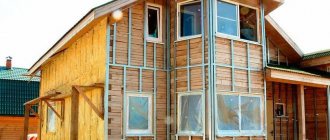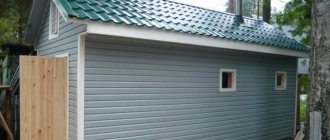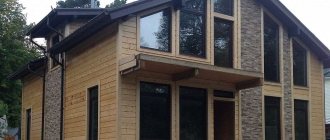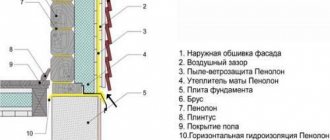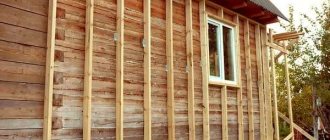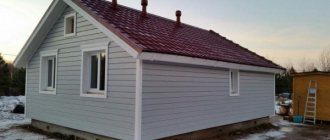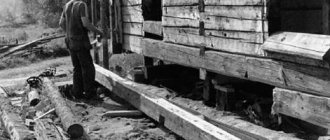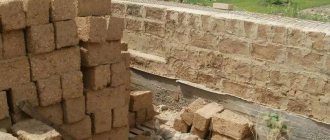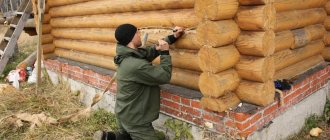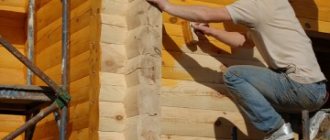Houses made of timber, due to their environmental friendliness, are a popular option for private construction. But although they heat up quickly enough and have good thermal insulation properties, insulating a log house is an urgent need for most households.
Installation of insulation on the walls of a house made of timber Source nd-prime.by
Differences between old and new technologies
Wooden construction in Rus' is a centuries-old tradition. For centuries, houses were built exclusively from log houses, from massive round and semicircular logs, the thickness of which was sufficient for good thermal insulation. Just like today, the tree dried out over time, and cracks appeared between the logs. But earlier there were other ideas about the beauty of the facade, so ordinary wood moss was used to caulk cracks. It landed in the cracks between the logs and over time reliably filled the entire space between them.
In modern construction, issues of economy come to the fore and force the use of timber, the thickness of which does not always meet the requirements of the developed standards. If the cross-section is insufficient, complete freezing occurs in winter, which means that the walls of the house are not able to retain heat. In addition, over time, the wood begins to dry out, causing heat loss to increase even more.
This is what a timber wall looks like after the wood has dried Source bredmozga.ru
Advantages and disadvantages of wall insulation in a log house
Thrifty owners are looking for ways to properly insulate a house made of timber so that they can spend less money on heating in winter. This can be done in two main ways: from the inside and from the outside, and external insulation is preferable for a number of reasons.
Features of insulation from the inside
With internal insulation, the positive effect of heat saving is offset by the disadvantages:
- Part of the usable area is inevitably lost due to the installation of a frame under the insulation.
- The thermal insulation layer hides the “living” wooden walls and the rooms lose their unique charm.
- Due to external winter cooling of an unprotected wooden wall, the dew point moves into the internal insulation. Condensation occurs, mold appears, and it is difficult to control the condition of the wood.
Is it necessary to insulate a wooden house under the siding?
Installation of thermal insulation is not always carried out; it is required in the following cases:
- Violation of the finishing structure. This situation is typical for old houses that need protection from moisture. The problem cannot be corrected by simply sealing the cracks.
- Insufficient wall thickness or inability to insulate the premises inside. This is especially true when the house is located in an area with a constant temperature below – 15–20 degrees.
- The need to replace the old decorative and thermal insulation layer. Over time, the insulation becomes unusable, which can be caused not only by the end of its service life, but also by improper installation.
- It is necessary to improve the energy efficiency of the building. Creating additional protection against heat loss allows you to save money.
On a note! A log house, built from high-quality wood with insulation of horizontal structures, does not require additional cladding of the facade.
Video description
What happens to the wall if the insulation is not properly insulated from the inside - in the video:
Insulation of walls from the outside: advantages and disadvantages of the method
Most often they resort to it, keeping in mind the obvious advantages compared to internal insulation:
- The usable area of the internal space is preserved;
- External work does not change the family's daily routine.
- The facade of the house is reliably protected from sudden temperature changes, which extends the life of the building.
- The correct selection of materials does not disturb the microclimate of the rooms (the house “breathes”).
- You can decorate the facade to your liking or improve the appearance if the wood has darkened over time.
- If the technology is followed, the wood will be additionally protected from damage.
- Ease of monitoring the work of the construction team.
The main disadvantage of external insulation is the need to carry it out in good weather; in cold and damp weather there is no point in doing this.
See also: Catalog of companies that specialize in insulating country houses.
What difficulties might you encounter?
The first problem that will arise in a new house is the drying out of the wood and the appearance of all sorts of holes and cracks.
Freezing of corners is a common problem if construction rules are not followed. At sub-zero air temperatures, condensation appears inside the room. It is he who is the culprit of mold and mildew on the walls.
The correct solution to the problem is to reliably seal the seams from the outside. Builders suggest using “liquid thermal insulation” in case of such troubles. Sealing is done along the perimeter, starting from the bottom corner.
Insulating a home is a responsible undertaking. It is imperative to follow the technology to avoid the appearance of rot, rotting wood and other problems.
Typical mistakes made due to inexperience:
- before work, the condition of the timber was not inspected, the surface was not prepared;
- construction materials were not transported and maintained according to regulations;
- all cracks have not been sealed;
- the building material was chosen incorrectly;
- The insulation is not tightly secured.
Advice. Do not use foam for interior work. Although it is cheap, it is not suitable for interior work.
Three main insulation methods
Any insulation of walls involves attaching a layer of insulation and structures holding it to it. Several methods have been developed for this purpose and each of them has its own advantages and implementation features.
The principle of wall insulation is the creation of an additional protective “pie” Source lestorg32.ru
Hinged ventilated facade
This technology itself was developed as a decoration for the facade of a house, but since the installation procedure involves attaching a layer of mineral wool or a similar material to the wall, this method can be considered as insulation.
Advantages of using ventilated facades:
- Long service life (up to 50 years), excellent heat and sound insulation.
- Easy to install.
- Wide selection of facing materials in various colors.
- The dew point moves outward.
Installation technology:
- Pre-treatment of lumber is carried out with compounds that prevent rotting and make the tree unattractive to insects.
- A sheathing is attached to the outside of the house, onto which a sheet of hydro- and wind protection is placed. Air circulates freely in the space between the sheathing slats, due to which condensation or moisture that appears in other ways will be removed from the insulation.
- The sheathing is leveled with a plumb level.
- Next, slats are placed on the sheathing, the distance between which should correspond to the width of the heat insulator. The height of the slats is selected accordingly - for central Russia it is recommended to use insulation with a thickness of at least 70 mm.
A feature of a ventilated façade is that a gap is left between the insulation and the cladding Source builderclub.com
- Insulation mats are placed between the slats, secured with dowels.
- Then bars with a thickness of at least 5 cm are additionally stuffed onto the slats so that there is always a gap between the insulation and the cladding.
- Cladding (siding) is installed.
Laying insulation under siding.
There are practically no fundamental differences from the previous technology - insulation is also used here and a decorative coating is also used on the outside. But if the very name of the ventilated facade indicates the place of its use, then in any case the entire house is covered with siding.
Installation nuances taking into account the selected material:
- The distance between the slats is set equal to the width of the mat if foam or sheet extruded polystyrene foam is selected.
- The distance between the slats is set to 10–15 mm less than the width of the mat if mineral wool is used. This must be taken into account when calculating the amount of mineral wool.
- According to the technology, wool slabs are mounted by surprise; polymer slabs are placed in cells, the joints are treated with polyurethane foam.
- When using mineral wool, a waterproofing layer (diffuse membrane) is additionally installed on top. It is not needed when using fiberglass or polystyrene.
Covering a log house with siding Source stroyfora.ru
Polyurethane foam spraying method
The principle of this technology is clear to anyone who has seen how they work with polyurethane foam. The difference here is that the volumes of material required to create a thermal insulation cushion are much larger, so a spray gun using compressed air from a compressor is used to process polyurethane foam. Advantages of the technology:
- Easy to use and high speed application of thermal insulation mixture on large surfaces.
- Excellent adhesion (cohesion) with most building materials, long-term preservation of properties.
- Environmental friendliness, fire resistance and protection against rotting of the treated surface.
Spraying of insulation can be done on any prepared surface Source keeninsulation.com
See also: Catalog of projects of houses made of timber presented at the exhibition “Low-Rise Country”.
Siding installation
Siding installation begins immediately after installing the counter-lattice. A straight horizontal line is struck from below, indicating the lower edge of the siding .
- The starting bar is installed along this line.
- After this, all corners are drawn up - external, internal, window or door openings.
- The design of window or door openings can be done in different ways, based on the depth of the slopes. Ordinary trims, universal strips, or, if the depth exceeds 20 cm, a set of siding panels can be used.
- After all the corner elements are installed and the openings are formed, the installation of siding panels begins. The first row is mounted on the starting bar, snapped into the lock and secured at the top with self-tapping screws.
Important! Do not tighten the screws all the way! The material must have free movement for movement during thermal expansion.
- All subsequent rows of siding are installed in a similar way. The longitudinal joining of the panels is done either using H-panels, which must be installed together with the corner and window elements, or with an overlap of 2.5 cm .
- The canvas is completed using a finishing strip, which is mounted together with the last row of panels. They are simply slipped under the curl of the strip, which fixes them in place and prevents water from getting under the trim.
Types of insulation
The choice of insulation for outdoor work is quite wide and each of them has distinctive features that must be taken into account when choosing:
Mineral wool
Available in three varieties - stone (basalt), glass and slag. All have similar properties: fire-resistant, non-flammable, chemical and biological resistance. Other advantages of the material include vapor permeability, environmental friendliness and high sound insulation.
The downside is that cotton wool attracts rodents and does not dry completely when wet.
It all depends on the skills of the builders, but usually insulating the outside of a house with mineral wool is easier to do using mats than rolls - the latter are not always convenient to deploy on vertical walls.
Laying mineral wool slabs in lathing Source remontik.org
Slab styrenes (foam plastic, polyurethane foam)
Polystyrene foam is the cheapest option, lightweight and porous, with low hygroscopicity and excellent thermal insulation. The main disadvantages are considered to be flammability (releases toxins when burned), fragility and instability when exposed to ultraviolet radiation.
Waterproofing mineral wool
Mineral wool is a hygroscopic material. Due to swelling, all its working properties are lost, which should not be allowed. Therefore, before installing the counter-lattice, you should install a cutoff - a layer of waterproof membrane. This material has the ability to allow steam to pass in one direction, but does not allow moisture in any form to pass through in the opposite direction .
The waterproofing is installed in horizontal stripes from below. The material is rolled, so it is possible to eliminate joints along the length. Subsequent rows are laid with an overlap (10-12 cm), the joints are taped with special tape. In this way, the entire area of the walls and the slopes of the openings are covered.
There should be no holes or cracks in the film . You need to ensure that the film is installed on the correct side.
Video description
In this video we will take a closer look at insulating a house with polystyrene foam. How safe is polystyrene foam?
Extruded polystyrene foam
It has a special porous structure, tolerates low temperatures well and is unsuitable for microorganisms. The material is durable, easy to install (slabs), and does not absorb water. Disadvantages: Highly flammable and releases harmful toxins.
Polystyrene foam and polystyrene foam are similar in appearance Source lineyka.net
How much will it cost to order work?
There is a decent selection of necessary materials for insulation on the construction market.
The average cost of turnkey work on wall insulation is 5,250 rubles. sq. m. The work includes the full range of services. The price includes the total cost of materials and delivery.
Price without consumables:
| Types of installation work | Cost per sq. m, in rub. |
| Installation of guides | 30 |
| Horizontal lathing | 50 |
| Vertical lathing | 150 |
| Windproof membrane | 30 |
| Insulation t=50 mm | 70 |
| Insulation t=100 mm | 120 |
| Vapor barrier | 100 |
| Plates | 200 |
| Impregnation of the surface with a protective layer | 70 |
Subtleties of insulating timber walls
Insulating a log house from the outside under siding cannot be started whenever you want - before this, the following conditions must be met:
- Work on installing insulation can begin only after the log frame has completely shrunk - often this period can be one and a half to two years.
- It is prohibited to carry out work if the façade has not been treated with an antiseptic. Ignoring this rule will lead to the appearance of fungus and rot.
- Before insulating a house made of timber from the outside, it is necessary to prepare the facade: seal not only wide cracks, but also small cracks. To do this, you can use putty, polyurethane foam or similar materials.
- Good thermal insulation of a log house requires careful selection of material and calculation of its quantity. It is necessary to consider how the thermal insulation material will be combined with the wood of the timber itself.
- To choose the right insulation, you need to take into account the size of the building, the quality of the frame and seams.
Some insulation is installed without lathing Source obustroen.ru
Common mistakes
The most common mistakes occur when technology is broken. For insulation, it is not recommended to choose soft roll insulation.
List of mistakes:
Use of unsuitable materials. Use of materials from different manufacturers.- Use of materials stored in inappropriate conditions.
- Carrying out insulation measures in case of rain, strong wind or strong sun.
- Failure to comply with deadlines for individual stages of thermal insulation work.
- Insufficient cleaning of the building walls from dirt, dust, and loose plaster. Incorrect caulking of cracks in walls.
- Installation of the system on an unstable basis.
- Errors in fastening the wall base profile.
Tools and materials for thermal insulation of buildings
To insulate a house without being distracted by searching for tools and materials, builders need to prepare the following:
- bubble or laser building level, you can also use a plumb line;
- tape measure, square or metal ruler;
- hammer, construction knife or hacksaw, screwdriver;
- facade dowels, tape, chalk, polyurethane foam, antiseptic;
- dry slats, insulation;
- vapor and waterproofing film;
- material for final cladding.
- sprayer for treating wood with protective compounds
Treating a wooden wall with an antiseptic Source mybesedka.ru
Why do you need a vapor-permeable membrane?
Cladding wooden walls using mineral wool requires creating free vapor exchange. For this purpose, a special covering material is used in the form of a film, which allows excess moisture to escape, but does not allow it to penetrate back. Such finishing products are laid on top of the insulation and fixed to the wooden frame posts with a stapler, and to the metal sheathing with double-sided adhesive tape.
Important! A high-quality membrane must be supplied with installation instructions, and also has markings that allow you to avoid mistakes in the location of the sides.
General progress of thermal insulation installation
All steps for insulating a house made of timber using any of the described methods are always schematically the same and are performed in the following sequence:
- to ventilate the first layer of insulation, a sheathing of wooden planks is mounted on the wall;
- a frame is placed on the sheathing to fix the insulating material
- installation of insulation;
- installation of additional sheathing and frame (if double insulation is used);
- laying an additional layer of heat insulation;
- fastening a diffusion membrane, which will provide water and wind protection.
- installation of facade finishing (lining, siding) with an air gap.
Of course, in the end, insulation will hide the beauty of the natural material, but finishing the house with a block house can be a solution.
Schemes: how to insulate a building with your own hands?
Let's consider the order of implementation of each technology.
Ventilated facade
Photo of the scheme:
In order for the structure to be reliable and durable, certain rules must be followed when installing it.
The thickness of the air gap is taken based on the architectural features of the structure and the insulating material. The gap is usually 4 - 8 cm.
Insulation is carried out with mineral wool, t = 10 cm. A profile box is first installed on the retaining walls of the building and a frame for the finishing material. Mineral wool insulation is then placed in its niches.
To protect the timber from wind and moisture, a membrane layer is installed behind the coating and thermal insulation layer. The insulation is sealed from the outside.
The final stage is wall cladding. For finishing, you can use wood materials, for example, block house. The choice of finishing type is influenced by financial opportunity, the desired appearance of the material and characteristics.
The lining is secured mechanically (with screws, clamps or other means), taking into account the thickness of the ventilation gap.
Wet method
Photo of the scheme:
Order of work and finishing:
- Wall cleaning, leveling, primer treatment.
- Installation of vapor barrier.
- Installation of thermal insulation boards with glue.
- Additional fastening with plastic pins.
- Applying glue to insulation.
- Reinforcement of holes.
- Primer and surface coating.
Laying under cladding
Instructions:
- Cleaning surfaces and leveling the surface.
- Installation of vapor barrier material.
- Installation of a wooden or metal frame.
- The next step is to coat the insulating material with glue. Next, a boot profile is executed that will support the first line. After the glue has dried, the facade insulation is additionally attached to plastic pins.
- Waterproofing must be installed on top of the insulation. For these purposes, it is recommended to choose a membrane with a water chamber and vapor diffusion. A film or membrane is attached. The joints are made with a coating of at least 10 cm and sealed with tape.
- After all steps have been completed, installation of the cladding begins. Carry out the work according to the instructions.
Spraying polyurethane foam
When using polyurethane foam as a thermal insulation layer with a thickness of 3.5 cm, an effect similar to using a mineral wool panel t = 12.5 cm is achieved.
Instructions:
- Polyurethane foam is applied to wooden formwork. Can be made of metal.
- Treat wood with an antiseptic, metal with an anti-corrosion compound.
- Cover the hardened foam with a vapor barrier film and cover the top with plasterboard.
Attention. Do not apply finishing materials directly to hardened polyurethane foam.
